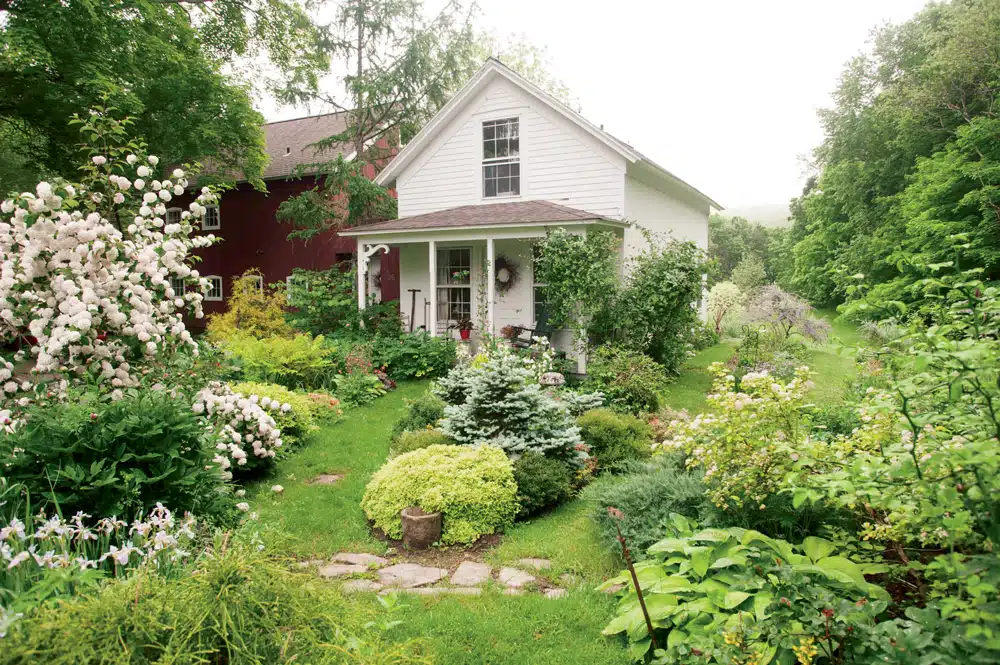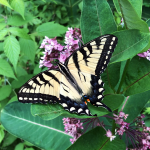Plot Twists | Gardening in New England
Years of trial and error gardening with flowers and shrubs, berries and vegetables, has taught this acclaimed gardening writer one thing: her land has a mind of its own.

Coffee By Design | Portland, Maine
Photo Credit : Katherine Keenan
Even before the snow melted and the ground thawed 20-plus years ago when I first came to these seven acres in Roxbury, Connecticut, I knew exactly where I wanted the garden. Before the leaky roof was addressed and the termite-infested basement was shored up, some muscle men were inveigled to dig a garden stretching from the converted 1790 cobbler shop, my current writing studio, to the street. The fact that the path layout sort of resembles a peace sign was accidental. Instead, the overarching design was configured so that flowers would always be just a glance out my office window. And from the opposite end, when neighbors strolled by with their golden retrievers, they would get a floral eyeful.
Back then, I thought of the garden in singular terms. Plural didn’t come until later.
As for the garden’s content, the repertoire was a total stab in the dark, except that flowers were definitely in its future. Searching for inspiration, I asked Miss Smith, the 90-something-year-old surviving member of the town’s founding family, whether in her recollection the property had ever hosted a garden. She pointed a shaky cane at the front yard and declared, “Of course. We had a potato patch right there.” It didn’t give me much to emulate.
I suppose that a 100-foot-long perennial border is more ambitious than what most first-time home-owners would want to tackle. As originally designed, a cottage garden seemed the only way to go, and that concept translated into solid perennials from my windows to the road. In retrospect, I overdid the floral contagion by a country mile. Much later, I doubled back to tuck in shrubs as large-footprint sentinels that would cut down on maintenance and give the garden structure. So this should tell you something right away: I’m not a professional landscape designer—just a gardener gone ballistic.

and she’s not done yet.
Photo Credit : Kindra Clineff
Initially, the colors stayed strictly in the pastel range, which seemed a safe palette for a newcomer to a staid New England town. Later, I unleashed my inner gypsy and let it rip with oranges, yellows, purples, and blues, which felt more like me. The front garden is in its umpteenth iteration, because evolution is the way of a gardener’s world. Maybe some people get it right on the first try, but most of us roll with the punches.
Change is not merely due to shortsightedness, either. Some plants like us; others do not. The giant patch of baby-blue Penstemon was doomed for reasons I’ve never pinpointed. The foxgloves were fruitful, but those mavericks had a mind of their own, inserting themselves wherever they weren’t planted. As for the so-called “perennial” foxglove (Digitalis x mertonensis), I learned not to count on many happy returns.
During those first few years, the garden would pretty much peter out by July. Lilies seemed to be the perfect solution until they were hit from top to toe by combined deer/vole/lily beetle attacks. Before I discovered a source for own-root roses (that is, roses grown on their own rootstock rather than grafts), that favorite shrub was, for me, an expensive annual. Alliums thrive for about three years and then require replenishing. And who among us doesn’t initially make the stumble of all newly minted gardeners—to bombard nurseries in spring and snap up every plant that is performing?
But gradually, despite two decades of dodging bullets, the place started to gain bulk. The way some women can’t pass up shoes, I can’t spot a nursery without making a U-turn. You’d be amazed what can fit in the back of a Volvo, or maybe you already know. But it wasn’t until my gardening reached viral proportions that the property earned its name. “Furthermore” seemed like a natural fit.

Photo Credit : Kindra Clineff
Food nudged the next stage of manifest destiny. From the start, a few sparse vegetables had been incorporated into the garden swath that stretched to the street, although I remember whining that the bolted lettuce was its only compelling feature by August. Five or six years later, edible greens got a little postage-stamp space of their own behind the converted cobbler shop. And that’s when inventive solutions really became my modus operandi.
Protecting the larder (unfenced at first) necessitated a series of creative deterrents, the most successful being a ring of rue (Ruta graveolens) interwoven with golden feverfew (Tanacetum parthenium ‘Aureum’) to fool deer into thinking that foul-tasting herbs were the sum total of this garden’s contents. It worked like a charm for deer, but apparently rabbits have a higher IQ. My double-barreled solution was to also enlist the red-leaved prince’s feather (Amaranthus cruentus) that appeared annually as self-sown volunteers throughout the garden. Sprayed with rotated Bobbex and Liquid Fence repellents, they deterred potential pantry-raiders.
Freshly harvested homegrown salads proved so irresistible that a full-fledged vegetable garden was the obvious spinoff. I designed an innovative circular garden with pie-wedge raised beds. Bad idea: The circular design toppled inward. So, after several fences had imploded, I found a master fence-maker to build a new eight-foot fence with a top board that stabilized it. By that time, I’d also added a teardrop-shaped berry garden bristling with blueberries, currants, blackberries, and gooseberries.
With the berry garden, I hit maximum weeding capacity—in fact, it pushed me over. In the battle against weeds, I’d tried all the usual. Landscape fabric took just a couple of years to shred into something bearing an uncanny resemblance to a trash dump. Annual mulching proved prohibitively expensive. Finally, underplanting the berry bushes with a dense mat of calamint (Calamintha nepeta) hit the sweet spot. Moreover, the airy mist of white flowers above small aromatic leaves is eco-friendly. After the berry blossoms delight pollinators, the calamint kicks in, preoccupying those industrious little workers for the remainder of the summer, while its interlocking stems keep weeds at bay.

Meanwhile, the neighborhood was giving me plenty of positive feedback as the garden in front matured. The alliums won constant acclaim, as did the columbines. However, the crabgrass that dominated the hell strip where the driveway met the street received no compliments whatsoever. The front lawn had to go.
I packed it with a closely knit tapestry of low-maintenance, low-growing shrubs, like Spiraea japonica ‘Magic Carpet.’ These mingled with bullet-proof perennials such as yellow foxglove, sedums, and asters, plus steadfast herbs. I planted them so densely that they literally wove one into the next. If the slightest hint of soil could be seen, an annual such as statice came to the rescue. That lost-and-found space now rubs its previous lawn incarnation in the dirt. Dog walkers give it two thumbs up.
More plans are in the wings. Someday, no lawn will dwell in my domain. I will plant wall-to-wall. And someday, too, the magic formula for maintaining a garden gone berserk will become evident. Until then, I intend to keep wigging out into oblivion.
Maybe I’ve learned only one thing for certain over the years: Gardening is incurable.
Tovah Martin’s latest book, The Garden in Every Sense and Season, which centers on the garden she calls Furthermore, was recently published by Timber Press.








Wonderful article. You are correct we do not get it right the first time. In 37 yrs. our fish pond has been filled in and dug out 3 times. This is our first yr. for a berry garden; and in all that time i have not learned a thing. Or have I ?
Do catmint and calamint attract cats?